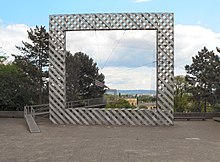Documenta
Documenta was founded by artist, teacher and curator Arnold Bode in 1955 as part of the Bundesgartenschau (Federal Horticultural Show) which took place in Kassel at that time.[10] Documenta11 was organized around themes like migration, urbanization and the post-colonial experience,[11] with documentary photography, film and video as well as works from far-flung locales holding the spotlight.[7] In 2012, documenta (13) was described as "ardently feminist, global and multimedia in approach and including works by dead artists and selected bits of ancient art".[13] Documenta's decision to feature some of its shows outside of Germany, in peripheral contexts has sparked numerous critical discussions that reaches an apogee around documenta14 which partly took place in Athens, Greece in 2017.Various critics raised concerns about the ways in which the institution's endorsement of Athens as a place of resistance and novelty entailed a patronizing Orientalist stance, linked to new forms of tourism and the enjoyment of underdeveloped sites of "crisis".[14] In 2022, Documenta caused three separate anti-Semitism controversies: one revolving around the banner Peopleʼs Justice (2002) by the Indonesian collective Taring Padi that contained anti-Semitic imagery; another on the inclusion of the Palestinian collective Question of Funding in the exhibition; and, lastly, the inclusion of a 1988 Palestinian liberation movement brochure by Burhan Karkoutly titled Presence des Femmes.[18] In response to the controversy spurred by Presence des Femmes, Documenta released a statement urging the artistic team to remove the drawings until they can be "appropriately contextualized"; scholars from the Archives of Women’s Struggles in Algeria stated: "[Presence des Femmes] was in solidarity by the Algerian women with the Palestinian people, in denouncing the crimes committed by the Israeli State.documenta IX's team of curators consisted of Jan Hoet, Piero Luigi Tazzi, Denys Zacharopoulos and Bart de Baere.documenta 12 occupied five locations, including the Fridericianum, the Wilhelmshöhe castle park and the specially constructed "Aue-Pavillon", or meadow pavilion, designed by French firm Lacaton et Vassal.They include 7000 Eichen by Joseph Beuys; Rahmenbau (1977) by Haus-Rucker-Co; Laserscape Kassel (1977) by Horst H. Baumann; Traumschiff Tante Olga (1977) by Anatol Herzfeld; Vertikaler Erdkilometer by Walter De Maria; Spitzhacke (1982) by Claes Oldenburg; Man walking to the sky (1992) by Jonathan Borofsky; and Fremde (1992) by Thomas Schütte (one part of the sculptures are installed on Rotes Palais at Friedrichsplatz,[35] the other on the roof of the Concert Hall in Lübeck).A continually expanding video and image archive is also part of the collection as are the independently organized bequests of Arnold Bode and artist Harry Kramer.



Documenta – Center for Dealing with the PastFridericianumexhibitioncontemporary artKasselArnold BodeBundesgartenschauNazismPicassoKandinskysite-specificdocumentationmodern artBauhausJoseph BeuysEntartete KunstFauvismExpressionismCubismBlauer ReiterPittura Metafisicaabstract artabstract paintingspop artminimal artkinetic artAdolf Wolflidocumenta (13)Jerry SaltzMarian Goodman Galleryanti-SemitismTaring PadiHito SteyerlBracha L. EttingerRanjit HoskoteNaomi BeckwithSolomon R. Guggenheim MuseumHarald SzeemannManfred SchneckenburgerEdward F. FryCoosje van BruggenJan HoetDenys ZacharopoulosCatherine DavidSimon LamunièreOkwui EnwezordocumentaII. documentadocumenta III4. documentadocumenta 5documenta 6documenta 7Rudi Fuchsdocumenta 8documenta IXdocumenta Xdocumenta11documenta 12Roger M. BuergelRuth NoackCarolyn Christov-Bakargievdocumenta 14Adam Szymczykdocumenta fifteenruangrupaUnited Arab EmiratesKarlsaueSchloss WilhelmshöheOttoneum7000 EichenHorst H. BaumannWalter De MariaClaes OldenburgJonathan BorofskyThomas SchütteLübeckHarry KramerHessenSmith, RobertaThe New York TimesThe Wall Street JournalRoberta SmithWayback MachineThe Art NewspaperARTnewsMichael KimmelmanFinancial TimesDer SpiegelNew York TimesThe Huffington PostInternational Herald TribuneHessische/Niedersächsische AllgemeineAustralian Broadcasting CorporationNancy MarmerArt in AmericabiennalesAfrican Photography EncountersArts in Marrakech (AiM) International BiennaleDakar BiennaleAsian Art BiennialBat-Yam International Biennale of Landscape UrbanismChengdu BiennaleGwangju BiennaleHerzliya BiennialIncheon Women Artists' BiennaleIstanbul BiennialInternational Roaming Biennial of TehranKochi-Muziris BiennaleNanjing BiennaleShanghai BiennaleSingapore BiennaleART Ii BiennaleBerlin BiennaleBiennale of DesignBrighton Photo BiennialBucharest BiennaleCoruche BiennialCourtray Design Biennale InterieurEstuaireFlorence BiennaleKyiv BiennialLight Art Biennale Austria 2010Liverpool BiennialManifestaMoscow Biennale